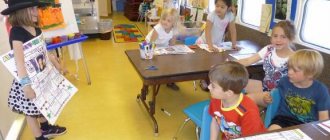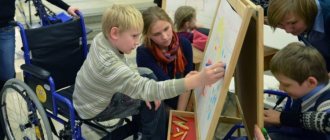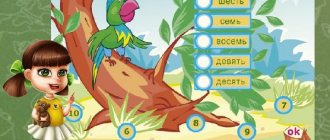Individual approach to teaching preschoolersmaterial
Municipal budgetary preschool educational institution
"Kindergarten "Ryabinka"
Individual approach to teaching preschoolers
Educator:
Nikitina Nina Olegovna
Gagarin
2019
An individual approach to teaching preschoolers is the work of a teacher with children, taking into account the individual characteristics of each child. In the educational program, in accordance with the Federal State Educational Standard, one can highlight the distinctive features of the Program: focus on taking into account the individual educational needs of the child; assessment of a child's development in comparison with oneself, and not with peers.
The conditions that the Federal State Educational Standard imposes on individual work in kindergarten occupy a significant place and contribute to the fulfillment of a number of conditions:
- Psychological - pedagogical conditions - taking into account the child’s individual abilities to perceive and assimilate information, as well as the psychological characteristics of the individual.
- Material and technical conditions - equipment of the group and assistance from parents.
- Personnel conditions – interaction of the teacher with other specialists.
- Requirements for a developing subject-spatial environment - all equipment and materials must be safe, multifunctional, variable, transformed, functional.
The issue of an individual approach to children has at all times attracted the attention of many outstanding teachers: both representatives of Russian and foreign progressive pedagogy. These are Y.A. Kamensky, Jean-Jacques Rousseau, K.D Ushinsky, N.K. Krupskaya, A.S. Makarenko, V.A. Sukhomlinsky. They noted that an individual approach is of great importance for the comprehensive development of the child’s personality, respect for his uniqueness, the desire to understand his complex spiritual world, as well as for the humane attitude of the teacher towards the child.
The upbringing of children in a preschool institution should be such that it develops creative activity, initiative, and activity.
Each person is unique and inimitable in his individuality, expressed in individual characteristics.
The need for an individual approach is caused by the fact that any impact on a child is refracted through his individual characteristics, through “internal conditions”, without taking into account which a truly effective educational process is impossible. Therefore, education and training should be based as much as possible on individuality.
An individual approach is aimed, first of all, at strengthening positive qualities and eliminating shortcomings. With the skill of the teacher and timely intervention, the painful process of re-education can be avoided.
What is the essence of an individual approach?
An individual approach is an active, formative, developmental principle of learning and the main principle of pedagogy. The very problem of an individual approach is creative in nature, but there are the main points of the approach to children:
- knowledge and understanding of children
- love for children
- thorough theoretical balance
- the teacher’s ability to think and analyze.
The teacher should not forget that the child is the subject of his own development, he is self-sufficient. But children should always feel supported by the teacher.
An individual approach requires a lot of patience from the teacher, the ability to understand complex manifestations of behavior; it should permeate all educational and educational work: when conducting educational activities, in routine moments, during walks, in independent activities.
The teacher’s knowledge of the capabilities of each child will help him correctly organize work with the entire group. However, for this, the teacher must constantly study the children, identify the level of development of each, the pace of his progress, look for the reasons for the lag, outline and solve specific tasks that would ensure further development.
One of the main factors in the educational process is taking into account the individual typological qualities of the child (type of temperament). The type of temperament is determined by the genetic characteristics of the individual. As a rule, it determines the pace of activity.
Depending on the individuality, the general age characteristics of the child manifest themselves in different ways. Every child is unique; no two characters are alike. The character and habits of a child are influenced by living conditions, environment, and characteristics of family upbringing.
An individual approach to the child is carried out both in the process of organizing collective classes and individual forms of work.
It is necessary to distinguish between an individual and differentiated approach to training.
As already noted, an individual approach to teaching preschoolers is the work of a teacher with children, taking into account the individual characteristics of each child.
Differentiation of education is the creation of conditions for the education and training of preschoolers with different abilities and problems, by organizing children into homogeneous groups that differ at the moment: in the level of mastery of the material; level of performance and pace; features of perception, memory, thinking; balance of excitation and inhibition processes.
Recommendations for a differentiated approach to teaching and raising a child:
- Visualization is very important when teaching preschoolers.
- In case of failures, do not be nervous yourself or make your child nervous, but find the reasons for the difficulties and look optimistically into the future.
- Praise your child for his successes and achievements without comparing him to others.
- The teaching methodology should be oriented towards a specific group of children or a specific child in such a way as to maximize their potential.
- The teacher needs to be as patient, understanding and mobile as possible.
- Do not blame your child for difficulties in communicating with him or for not understanding each other.
- It is impossible to learn something without making mistakes, so a child should not be afraid to make mistakes. The feeling of fear is a bad advisor. It suppresses initiative.
- Do not scold your child for his inability, but try to understand the nature of the difficulties and help him find ways to solve the problem.
- The main thing for a teacher should be not so much to teach a child something, but to make sure that the child wants to learn, without losing interest, and feels a taste for learning new things.
- In every possible way stimulate, support, and nurture the child’s independent search without presenting the truth.
- Recognize children's right to individuality.
Also, do not confuse individual training with an individual approach to learning. If the first involves the “Teacher-Child” system, then in the second case the teacher works with a group of students, but at the same time takes into account the characteristics of each child individually.
An individual approach in classes helps to reveal the child’s individuality. The technology of an individual approach includes several interrelated stages:
- Studying the characteristics of a child through observation, special games, questionnaires, tests, techniques.
- The information is analyzed, the teacher draws conclusions and focuses his attention on the most important.
- Having analyzed all the conditions, the teacher outlines the tasks, methods and forms of work with each child individually.
- After a deep analysis, you can begin to implement the intended goals, to carry out the planned work in classes, in communication, in games, in everyday life.
The teacher needs to keep a notebook or diary, in which the characteristics of children should be described and brief conclusions of the observation results should be drawn to study the individual characteristics of children. A profile is compiled for each child, which includes:
- General information about the child.
- Physical condition data.
- Positive manifestations of the child.
- Relationships with the team.
- Attitude to work.
- Features of mental development.
- Pedagogical conclusions.
Over time, factors affecting the child and personal development may change, so it is important to remember that such work must be carried out constantly.
When organizing work, the teacher should rely on the following indicators:
- The nature of the switching of mental processes (flexibility and stereotypicality of the mind, the speed or sluggishness of establishing relationships, the presence or absence of one’s own attitude to the material being studied).
- Level of knowledge and skills (awareness, effectiveness).
- Performance (ability to act for a long time, degree of intensity of activity, distraction, fatigue).
- Level of independence and activity.
- Attitude to learning.
- The nature of cognitive interests.
- Level of volitional development.
The teacher must remember that there are no uniform conditions for success in learning for all children. It is very important to identify the inclinations of each child, to reveal his strengths and capabilities, to let him feel the joy of success in mental work.
The teacher will have the opportunity to help the “weak,” pay attention to the “strong,” and work more effectively with children experiencing learning difficulties.
Children with learning disabilities require a special form of educational activity. A child who has unstable attention and insufficiently developed memory will not be able to complete many of the traditional tasks; in this case, a special form of presentation of the material is required. Children with learning disabilities also need special attention from the teacher to develop their abilities.
This means that even with full academic performance, all preschool children require an individual approach.
In practice, unfortunately, teachers most often notice those children who attract attention with their successes, or those who do not cope well with completing tasks. The rest of the children, as a rule, remain on the sidelines.
Taking into account the individual development of a child is especially important in older preschool age, when the foundation for successful schooling is laid. Organizing individual forms of interaction between the teacher and children in the classroom helps to ensure a high level of independence for children and the development of their educational skills.
According to E.A. Arkin, “intimate contact” is important in studying the individuality of each child. By “intimate contact” we need to understand the establishment of such relationships in which the child would see in an adult a person who is deeply interested in him, from whom his experiences find a sincere, lively response.
Parents must be involved in individual work. To do this, you can organize joint exhibitions “This is how we can do it”, “Together with mom and dad”; Conducting conversations, consultations, designing folders - movements, questioning. The final form of cooperation with parents can be “Family Day”.
Thus, an individual approach is the work of a teacher with children, taking into account the individual characteristics of each child; it is of great importance for the formation of the child’s personality and permeates the entire educational system. The essence of the individual approach is that the teacher solves the problems facing him through pedagogical influence on each child, taking into account his psychological characteristics and living conditions.
The principle of an individual approach should permeate all levels of educational and educational work with children of different ages.
Scientific principle
Real knowledge must be provided while teaching a young child. You cannot simplify the material to the point of being schematic or distort it. A child remembers all information between the ages of 2 and 7 years. If the base is incorrectly formed, the child’s ideas will be greatly distorted.
The principle of science in the study of nature
In the process of teaching a child, specific ideas and knowledge about the world around him should be formed. All knowledge acquired should not conflict with the school curriculum. Didactics deals with this problem when teaching children of primary preschool age. She tries to prepare educational material in such a way that it is understandable to young children, but has a correct scientific basis. A thorough study of the curriculum for preschool children helps to create a powerful base on which it will be easier to string all school material.
Features of the scientific approach in the process of education are the formation in children of a unified picture of the world and a correct understanding of the laws of nature. It is very difficult to indicate the age of a child when basic concepts of the universe are formed. Many representatives of preschool education are inclined to believe that these basics should be an integral part of the education process.
From a very early age, children need to form correct ideas about the world around them, based on modern scientific knowledge.





